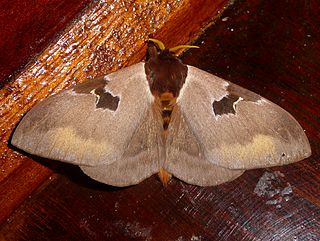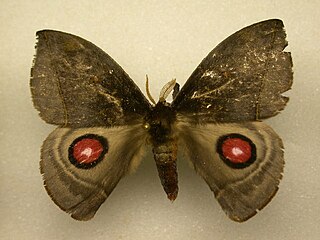
Saturnia is a genus of large silkmoths in the family Saturniidae, which the German biologist Franz von Paula Schrank first described in 1802. Its members are commonly named emperor moths, though this is also used for various close relatives in subfamily Saturniinae. Most species are Palearctic, but three, commonly called "saturnia moths", inhabit the chaparral of California: S. mendocino, S. walterorum, and S. albofasciata.

Actias ningpoana, the Chinese moon moth, is a species of moth in the family Saturniidae. The species was first described by father-and-son entomologists Cajetan and Rudolf Felder in 1862. It is quite large, and has long, curved, hindwing tails. There are many congeners across Asia; the Luna moth of eastern Canada and the United States is a close relative.

The Saturniinae or saturniines are a subfamily of the family Saturniidae, also known as giant silkmoths. They are commonly known as emperor moths or wild silk moths. They are easily spotted by the eyespots on the upper surface of their wings. Some exhibit realistic eye-like markings, whilst others have adapted the eyespots to form crescent moon or angular shapes or have lost their wing scales to create transparent windows. They are medium to very large moths, with adult wingspans ranging from 7.5 to 15 cm, in some cases even more. They consist of some of the largest sized Lepidoptera, such as the luna moth, atlas moth, and many more. The Saturniinae is an important source of wild silk and human food in many different cultures.

Perisomena caecigena, the autumn emperor moth, is a moth of the family Saturniidae, first described by Franz Josef Kupido in 1825. It lives in Italy and then from south-eastern Austria through Hungary, Slovenia, Croatia, Serbia, Albania, the western Ukraine, Romania, Bulgaria and Greece to most of Turkey and the Caucasus Mountains of the Republic of Georgia, Armenia and Azerbaijan. There is also an isolated population in the mountains of Lebanon and Israel. Subspecies stroehlei is endemic to the Troodos Mountains of Cyprus.
Eochroa is a monotypic moth genus in the family Saturniidae erected by Felder in 1874. Its only species, Eochroa trimenii, was also described by Felder in the same year. They inhabit arid rocky areas and mountain passes in Africa where the host plant grows.
Bathyphlebia is a genus of moths of the family Saturniidae. The genus was erected by Cajetan Felder in 1874.

Cercophaninae is a subfamily of the family Saturniidae, and was, until recently, treated as a separate family, Cercophanidae.
Cercophana is a genus of moths in the family Saturniidae first described by Cajetan Felder in 1862.
Automerella is a genus of moths in the family Saturniidae first described by Charles Duncan Michener in 1949.
Automerina is a genus of moths in the family Saturniidae first described by Charles Duncan Michener in 1949.

Dirphia is a genus of moths in the family Saturniidae first described by Jacob Hübner in 1819.

Dirphiopsis is a genus of moths in the family Saturniidae first described by Eugène Louis Bouvier in 1928.

Gamelia is a genus of moths in the family Saturniidae first described by Jacob Hübner in 1819.

Hemileuca is a genus of moths in the family Saturniidae first described by Francis Walker in 1855.

Paradirphia is a genus of moths in the family Saturniidae first described by Charles Duncan Michener in 1949.

Polythysana is a genus of moths in the family Saturniidae first described by Francis Walker in 1855.
Homoeopteryx is a genus of moths in the family Saturniidae first described by Felder in 1874.
Tagoropsis is a genus of moths in the family Saturniidae first described by Felder in 1874.

Usta is a genus of moths in the family Saturniidae first described by Hans Daniel Johan Wallengren in 1863.












